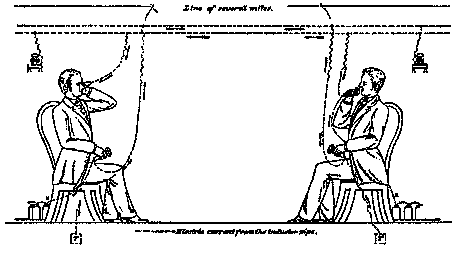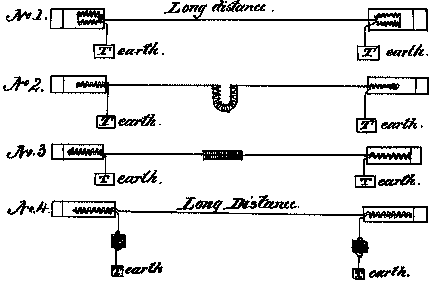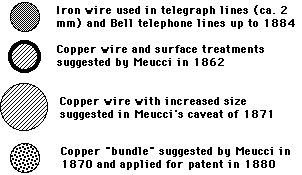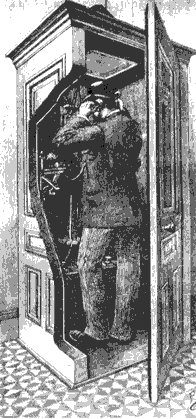
THE WEEK OF THE ITALIAN CULTURE IN CUBA
Havana, 19-25 November 1999
Note 1.-- All information reported below is taken from the book by Basilio Catania "Antonio Meucci - L'inventore e il suo tempo" (Antonio Meucci - The Inventor and His Times).
Panel D0 Meucci's experiments, both in Havana and Clifton, on the electrical transmission of the human voice, are basically substantiated by Meucci's own testimony at the Bell/Globe trial of 1885-1886 and by some fifty affidavits, sworn by various witnesses between 1880 and 1885.
In addition, his electromagnetic telephone was described in L'Eco d'Italia of New York at the beginning of 1861, though all issues of the 1861-1863 period are not available in the major libraries of the United States. Havana's experiments were briefly mentioned in a letter by Meucci, published by Il Commercio di Genova of 1 December 1865 and by "L'Eco d'Italia" of 21 October 1865 (both existing today).
Finally, a caveat (or preliminary patent) titled Sound Telegraph (*), setting forth the basic principles of Meucci's telephonic system, was filed with the US Patent Office on 28 December 1871, five years before the first Bell patent, and its validity was extended up to December 1874, by paying the corresponding fees.
In the following panels five of Meucci's achievements, that are of paramount importance to the telephone system, are presented, which unquestionably demonstrate Meucci's priority.
______________
(*) Meucci, Antonio, Sound
Telegraph, US Patent Office Caveat No. 3335, filed Dec. 28, 1871;
renewed Dec. 9, 1872; Dec. 15, 1873. File wrapper kept at the
National Archives and Records Administration, College Park, MD (USA)
- RG60, File 6921-1885, Box 10, Folder 1, and also at the National
Archives and Record Administration, New England Region, 380 Trapelo
Road, Waltham, MA, under Records of the Circuit Court of the United
States, District of Massachusetts, "United States of America vs.
American Bell Telephone Co. and Alexander Graham Bell," Exhibit from
Defendants.
Panel D1 - Anti-sidetone circuit
Meucci began investigating topics related with the telephone "system" in 1858, as shown by a drawing of the same year, reproduced below. This drawing formed the basis for Meucci's caveat of 1871, but, as Meucci's lawyer did not file it with the caveat, it was later notarized by Meucci himself in his affidavit of 9 October 1885.

The drawing shows a two-way, simultaneous, telephone conversation, with a complete separation between the two directions of transmission (indicated by arrows). This contrivance is aimed to counteract the so-called "side-tone" effect, that is, the hearing of the echo of the speaker's own voice (as well as any background noise) in his own receiver. This layout is known today as a "four-wire circuit". With it, Meucci anticipated any other inventor, as proved by the following:

The drawing reproduced above is taken from a note jotted down by Meucci in his Laboratory notebook on 27 September 1870, and reported in an affidavit by M. Lemmi of 28 September 1885, containing the English translation of said notebook (see also my paper on "Antenna").
It can be seen that diagrams "No. 2" and "No. 3" differ from "No. 1" in the insertion midway along the long-distance line of an inductor (with either a horseshoe or bar iron core). In diagram "No. 4," the inductor is split into two parts, inserted at both ends of the line. In his notes, Meucci pointed out that, in this way, he could get rid of the battery, and that, by splitting the inductor, he obtained better results.
This technique is known today as the "inductive loading" of long distance telephone lines, allowing to increase the distance and/or the quality of speech. The proof that Meucci came first, can be drawn from the following events, occurred many years after Meucci's discovery (or its notarization):
Panel D3 - Means to counteract the skin effect (see drawing below by B. Catania)
Because of the increased bandwidth of the telephone with respect to the telegraph, telephone lines were subjected to increased attenuation, due to the so-called skin effect.
In two notes of 1862 in his Laboratory notebook (notarized in Lemmi's affidavit of 1885), Meucci suggested to treat the surface of the (copper) conductor in various ways (basically with graphite) to increase its surface conductivity.
Moreover, in his caveat of 1871, Meucci stated: “I believe it preferable to have the wire of larger area than that ordinarily employed in the electric telegraph.”
Another note in his notebook, dated 17 August 1870, reads: “To be adopted, for having long distance, bundles of copper wire insulated with cotton or any other kind of wrapper; by this means I have obtained a distance of about one mile.” For this "bundle" of copper wires Meucci filed a US patent application "Wire for Electrical Purposes" on 2 July 1880.

That Meucci was first in said techniques, is proven by the following facts:
Panel D4 - Call signaling
In his scheme of 1858 (see drawing of Panel D1), Meucci adopted a telegraphic call signaling, simply effected by a Morse key, attached to each end of the line, momentarily short-circuiting the local transmitter. In this way, strong pulses of current were sent along the line, and the distant receiver would emit intermittent ticks, much louder than the ordinary speech. In his caveat of 1871, Meucci gave a detailed description of his call signaling, consistent with this scheme.
For what concerns the call signaling in the Bell system, we may first remark that no mention of it is found in the first Bell patent nor in Gray's caveat of 1876. Only a vague mention of a (not better specified) "call bell" is found in Bell's second patent of 1877. For several months after commercial telephone service was started, in 1877, the Bell subscribers resorted to either thumping the diaphragm or shouting into it, to call the other party. Less rudimentary call signaling was adopted in the years to follow, but Meucci must be credited for having identified the problem and offered an ingenious and inexpensive solution to it, many years before the Bell Co.
Panel D5 - Quietness of the environment
 French telephone booth of 1884 |
With early (electromagnetic) transmitters, received
speech signals were quite feeble and noisy, therefore,
quietness of environment was of paramount importance,
especially for long-distance links. In his caveat of 1871,
Meucci clearly stated: “When my sound telegraph is in operation, the parties should remain alone in their respective rooms, and every practicable precaution should be taken to have the surroundings perfectly quiet.”
The need for a quiet environment was recognized by A. Graham Bell and his assistant, Thomas Watson, only in 1877, on the occasion of Bell's public demonstrations in New York, when the first rudimentary soundproof booth, devised by Watson, was utilized.
An impressive number of patents for soundproof booths were applied for, starting from 1883. Antonio Meucci should, however, be credited for having identified the problem and suggested adequate countermeasures, in 1871. |
![]()